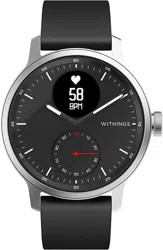Loading ...
Loading ...
Loading ...

EN-69
ScanWatch
v1.0 | August, 2020
Tracking my SpO2 (oxygen saturation)
What is SpO2?
SpO2 stands for peripheral capillary oxygen saturation, an estimate of the amount
of oxygen in the blood. More specifically, it is the percentage of oxygenated
hemoglobin (hemoglobin containing oxygen) compared to the total amount of
hemoglobin in the blood (oxygenated and non-oxygenated hemoglobin).
It is often considered to be the fifth vital sign, along with pulse, respiratory rate,
blood pressure, and body temperature.
Hemoglobin is a protein that carries oxygen in the blood to your organs. It is
found inside red blood cells and gives them their red color. Once oxygen is in our
organs, it acts as the fuel that allows our cells to work.
How is it measured?
SpO2 can be measured by pulse oximetry, an indirect, non-invasive method—
meaning it does not involve the introduction of instruments into the body. It
works by emitting and then absorbing a light wave reflecting the blood vessels, or
capillaries, in the wrist.
• Oxygen-rich blood absorbs infrared light better than oxygen-poor blood.
• Oxygen-poor blood absorbs red light better than oxygen-rich blood. This is
why venous blood is darker than arterial blood.
ScanWatch uses a multi-wavelength sensor called PPG (photoplethysmography)
sensor that emits and measures red and infrared reflections on the blood vessels
in the wrist. The algorithm then compares the reflection at each wavelength to
compute the SpO2 value.
Loading ...
Loading ...
Loading ...
